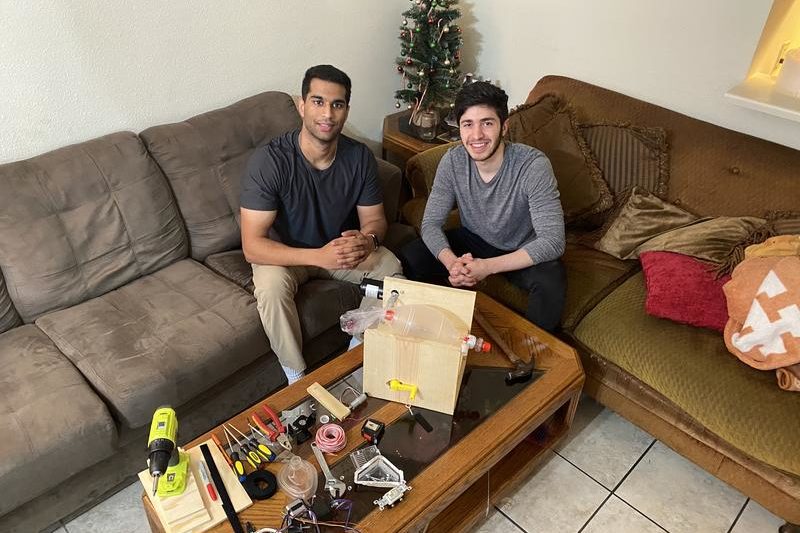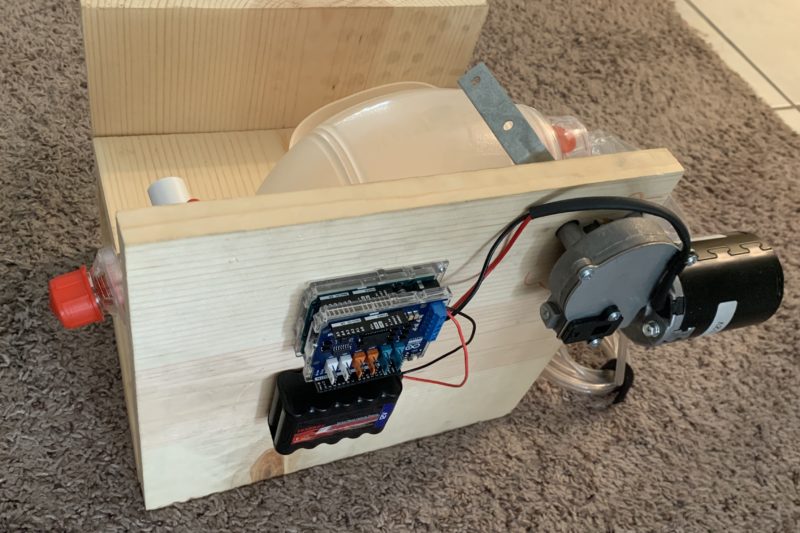Austin-based Roommates Develop Low-cost Ventilator Unit Amid COVID-19 Pandemic
By Nataleah Small
Reporting Texas

Roommates Raghave Upadhyaya and Adam Saleh with their ventilator. Courtesy Adam Saleh
Editor’s note: This story has been updated.
Two Austin-based roommates have developed a low-cost ventilator unit made from parts widely available around the world in response to global shortages amid the COVID-19 pandemic. In vitro testing on pig lungs for their prototype could begin soon at Dell Medical School.
Regulatory approval for such devices could come much faster than usual, potentially within months, under U.S. Food and Drug Administration testing regimes that are being accelerated in response to the crisis.
Adam Saleh, UT-Austin biomedical engineering alumnus, and Raghave Upadhyaya, UT-Austin computational science, engineering and mathematics graduate student, created the unit to ensure that anyone who needs a ventilator can access one, Saleh said.
“This pandemic really teaches us that the health of your neighbors and the health of the human population as a whole directly impacts your own health,” Saleh said. “It is in the best interest to make sure that everybody across the world has access to better healthcare treatment.”
Whereas traditional ventilators cost upwards of $30,000 and have many features, their prototype is less complex and only costs about $130 to produce, Saleh said. The unit is made from easy-to-find components such as wood, an artificial manual breathing unit [AMBU] bag and an electric motor, said Saleh. Making the device as scalable as possible drove their design choices.
“Once you restrict yourself to these low-cost items, you can really find a lot of things at Home Depot, Amazon [or] Lowe’s,” Saleh said.
The ventilator’s main component, the AMBU bag, is compressed by a small metal arm controlled by the motor. The AMBU bag is attached to the unit with a Velcro strap for easy removal in the case of an emergency, Saleh said.

Upadhyaya and Saleh’s prototype ventilator cost about $130 to produce. Courtesy Adam Saleh
The team chose to use an AMBU bag as the central part of the unit because it is considered the gold standard for resuscitation in hospitals across the world and has been approved by the U.S. Food and Drug Administration, Saleh said.
“Given that we are providing just a method of compression for [the AMBU bag], it is essentially just acting as a bridge device where, instead of using a person, the device is [compressing the bag] itself,” Saleh said.
The ventilator is powered by a battery pack that lasts up to eight hours, Saleh said. The battery can be recharged using a hand crank installed on the side of the unit, eliminating the need for electricity and making it fully portable.
“The idea came to us when we were thinking … if the lights go out, what do you use to see?” Upadhyaya said. “We thought about hand crank flashlights and radios, and that idea came to us from that and we could incorporate it into our device.”
The team members said they approached their design from a global perspective because both of their families are from developing countries.
Saleh’s family is from Lebanon; equal access to health care is important to him because some of his family members are immunocompromised. Upadhyaya’s family is from India, a country with high population density and little access to health care.
Because COVID-19 affects people across the world, Upadhyaya said, people will need to think globally when addressing this pandemic.
“It’s not going to be just one country that can fight this problem or address this problem by itself,” Upadhyaya said. “It’s going to take each and every person to go along with it.”
While developing the prototype, the team consulted with Dell Medical School professors Donald Elbert, John Uecker and Ziv Beckerman about design and functionality. Beckerman, an assistant professor of surgery, worked with Saleh in the past to build a simulator for a beating heart for surgical education purposes.
Dr. Beckerman told the team about the types of functionality that are required from a ventilator.
“A ventilator is a bit more complex than just a machine that pumps air in and out of the patient,” Beckerman said. “It has various other parameters that should be monitored and adjusted as needed.”
In its current form, Beckerman said, the unit could help ventilate patients with mild to moderate lung disease if traditional ventilators were unavailable. But before the unit can be used on human beings, he said it will need to undergo testing to ensure that it can operate safely for an extended period.
“It can serve both as a bridge to recovery, hopefully, or the bridge to requiring different ventilator support,” Beckerman said.
Arnold Estrada, a biomedical engineering research fellow, said under typical circumstances, the FDA testing and approval for new ventilators can take a year or more.
But due to the pandemic, if companies or research groups apply for Emergency Use Authorization from the FDA, Estrada said, they can undergo an expedited testing and approval process.
Estrada is part of the Austin Bridge Breathing Unit team developing a different ventilator prototype. His team has applied for the emergency authorization. Although an exact time frame is unknown, he said, the FDA has been responding to the requests within days, and he hopes the testing will take no longer than four weeks.
“The extent of, and timelines for, review of such submissions will be determined on a case-by-case basis and will depend on the nature of the submission, the circumstances of the emergency, and the workload of the review staff,” according to the FDA website.
Upadhyaya said that although their AMBU bag-based unit is not ready for mass production, the team has been in talks with the Texas Health Catalyst, a program housed in Dell Medical School that provides support to researchers and entrepreneurs.
For now, Upadhyaya and Saleh are focusing on the in vitro testing. They will then review the results, make any necessary design changes and plan to apply for FDA approval by the end of May.
“We’re definitely still hungry to keep working on this,” Saleh said. “We have a prototype and we want to take it to the next level before we can be satisfied.”